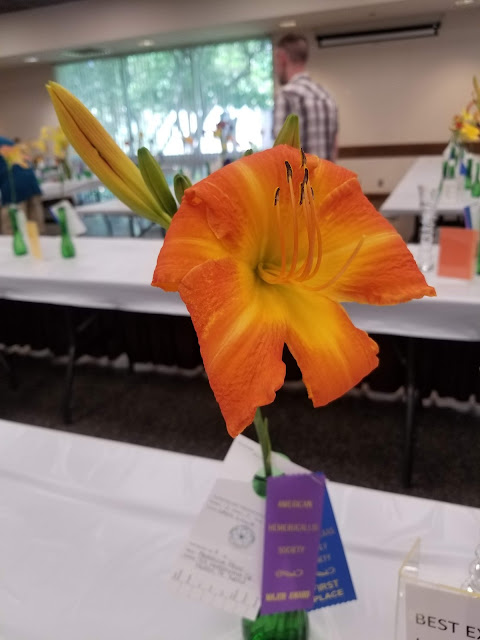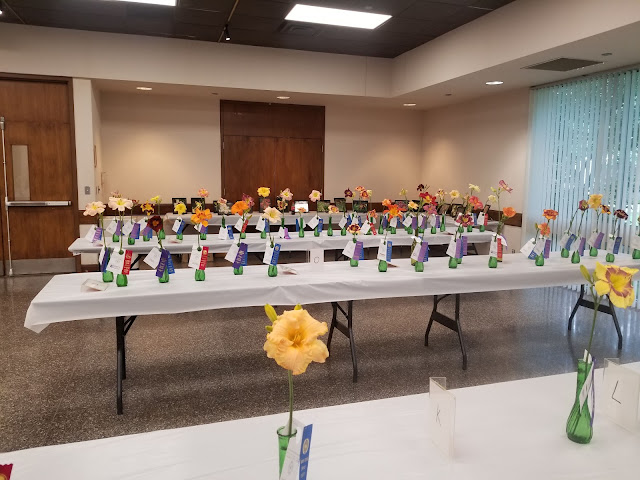Clerking a Daylily Show
If you visit a Daylily Show, typically this is what you will see. Rows and rows of daylilies, lined up like little well groomed soldiers.
This year I volunteered to clerk our club's show and it was really interesting. Basically I helped the judges by moving flowers (they aren't allowed to touch the vases), attached ribbons, and looked up individual plants when they needed clarification. You can learn a lot this way. It also meant I got to learn a lot about how they judge and what is important. They say if you want to get better at showing flowers, clerking is a great way to do it.
Most people loose points for issues with grooming. When you prep a plant for a show you need to clean it up first. Spider webs are bad, stray pollen is bad, anything brown is bad. Ideally, you remove these things to maximize the points your flowers is awarded. Your entry should look green and fresh.
Here is some thrip damage to the plant's scape. Interestingly, they can only judge the portion of the plant that is above the vase, so if this damage had been lower it would not have resulted in a deduction. It's been a bad year for this here in DFW and a lot of scapes had this kind of damage. Sometimes you can gently scrape it off exposing green below, but you may get points off for that too. Lots of people just leave it be.
Here is a bud scar that should have been trimmed. Ideally, you show flowers that are the first bloom on the scape, but that isn't always how things work. If you have bud scars you freshen them up before you put your flower out. All you need to do is take an exacto knife and slice a little bit of it off. This makes it look fresh and green, which is the point of grooming. You can see one that was cleaned up below. This entry also had a lot of little brown edges on the petioles and petiole scars. This also should normally be cleaned up.
There are some things you can "groom" away from an entry, but the picture below isn't one of them. This flower's color is blotch and water marked. Both of these things can result in deductions. The flower's color also needs to match up with it's registration data.
Here is another good looking flower that was in good shape, until you check out the petals more closely....do you see it?
I bet you can now.
If you ever visit an accredited American Daylily Society Show you will notice that after the judging is complete that the there are a few different types of ribbons awarded. Red ribbons scored at least 85 points, while blue ribbons scored at least 90 points. Purple ribbon recipients scored 95 points out of 100. Every flaw that the judges notice results in a point deduction.
To find out more about showing daylilies and how show work, visit the Exhibitions page on the American Daylily Society's website. It's definitely a strange process, breaking the beauty of a flower down into numbers so it can be quantified and compared to other similar flowers, but it's is also strangely fun (especially when you win).
This year I had two entries make it to the main table; Best Extra Large Flower and Best Seedling. Hopefully I'll do as well next year with all my new first hand judging knowledge.
 |
| Best Extra Large Flower: 'Lady Lillie' |
 |
| Best Seedling |










Congratulations on your awards! And very interesting to know a bit about judging a flower show like that!
ReplyDeleteInteresting post, not that any of my small collection of daylilies will ever see a show. Is that your seedling?
ReplyDeleteIt is. This is the first year we have had blooms in the seedling bed! Can't wait to see what happens next year.
Delete